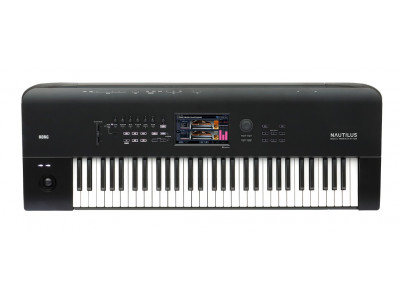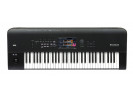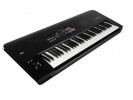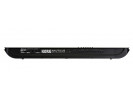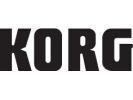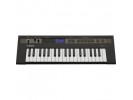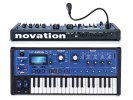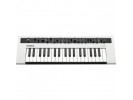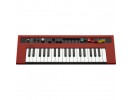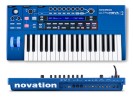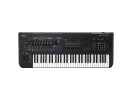NAUTILUS pushes the boundaries of what a performance synth and workstation is capable of. With the power of nine engines to drive a new approach to sounds, plentiful sampling, audio recording, effects, and processing power, there is simply no other synth that delivers more to explore sonically, with the workflow to get you there faster than ever. Korg spent years refining all our digital, analog, processing, and hardware technologies and delivering them in a way that helps the musician connect with their instrument. The result is the incredibly powerful, one-of-a-kind NAUTILUS.
The NAUTILUS features nine dedicated sound engines to realistically reproduce sounds such as pianos, electric pianos, organs and more.
To start, the enhanced SGX-2 piano sound generator offers delicate expressiveness to capture all the nuances of the acoustic piano, and NAUTILUS features the most piano libraries ever put into one product; with 12-step velocity-switched sound, string resonance and more. The EP-1 electric piano sound generator realistically reproduces seven different famous electric piano sounds. The CX-3 engine – the heart of our sought-after CX-3 reissue -covers the distinct sound of classic tonewheel organs. Add to that MOD-7 VPM/FM synthesis, the PolysixEX and MS-20EX for analog modeling, and the STR-1 for physical modeling, and you have essentially an engine for any type of sound you’re looking to get. Used together in Program or Combination mode, these distinctive engines create completely new timbres.
The approach to the included sound on NAUTILUS, started with Korg setting aside our preconceptions of what sound should be like on a conventional music workstation, and instead focused on pushing the boundaries of sampling and programming to create a brand-new classifications of programs that we divide into three groups:
“Unique” sounds:
The NAUTILUS brings you distinctive sounds including phrase loops, prepared pianos, found percussion and more. Many seldom heard-of musical instruments found in different regions around the world can be difficult to play, but distinctive phrases played on these instruments are featured on the NAUTILUS. Use these phrases as-is in your songs—let your imagination be your guide. The NAUTILUS features sounds that were sampled for the first time just for this instrument, including prepared piano sounds created by placing different objects between piano strings and recording samples, or “found percussion” sounds made by turning ordinary items into instruments to be struck. Not only do these novel and mysterious sounds provide an unexpected flavor to your songs, they offer broad possibilities for sound effects used in film and TV music as well.
“Current” sounds:
The NAUTILUS also offers the freshest sounds that blend in well with today's music scene, including synths, drum kits, special effects and more. For synths, be sure to check out the EDM, electro and chiptune sounds for starters. Also, the NAUTILUS features more than 50 kinds of drum kits—sounds that most strongly reflect the changes in music over time. The special effect sounds offer useful material like drums added to dance music to create beats—sounds that you can put to use right away.
Standard sounds:
We’ve brought together all of the most important sounds a workstation needs including piano, electric piano, guitar, bass guitar and more, covering all genres. For the newly sampled piano sound, we’ve also recorded the lovely sonic ambience of the studio, and you can mix the piano and ambience sound as you like with the new ambience sound. A new electric piano model with a characteristic thick sound has been added, which works great for funky playing styles. We’ve also added many phrases that let you play back actual performances of guitar and bass parts that keyboardists will find useful.
With the DYNAMICS knob, you can instantly control the changes in volume and tone in response to how hard you play the keyboard (velocity); and you can customize this knob in real time to match the keyboard playing feel required for each style and song. Even when playing the same sound, you can turn this knob to get the feeling of playing a completely different sound. By finding just the right setting for your playing style, you'll uncover even more of the possibilities that the NAUTILUS offers.
When you activate the DYNAMICS knob and turn it to the left, the keyboard responds more softly to your playing, giving you a wide range of dynamics. This allows for delicate, expressive playing when accompanying a piano solo or vocals, which directly reflects the dynamics of your performance. On the other hand, turning the knob to the right gives a stronger, more flat dynamic response. This brings out the sound when you’re playing in a band or ensemble, which works best when performing with a more even feel.
The six RT (real-time) knobs at the top left of the panel give you direct control over changes to the PROG and COMBI sounds. A variety of functions are assigned to each knob that lets you enjoy making changes to sounds, such as the filter cutoff and effect depth, the gate time, tempo and swing of the arpeggiator or drum track, the type of snare drum and more. In COMBI mode, you can group timbres and control their levels with the knobs. Further, you can press these knobs into the panel to lock them in place, preventing them from being accidentally changed while you’re playing. For instance, you could use this to enable only the knobs you often use onstage and push the ones in that you do not need.
For the NAUTILUS, we have completely rethought the user interface, considering that panel controls tend to become denser as more functions are added. The interface of the NAUTILUS lets users find just the things they’re looking for once they understand the principles.
The MODE button lets you see what you’ve selected in each mode on a single screen, from PROG and COMBI to the set list, sampling, sequence and global modes. Each mode has tabs for each function, and the PAGE buttons offer more detailed editing with consistent operations. With the user-friendly navigation of the NAUTILUS, you can press the MODE button at any time to return to the start if you get lost. A dark mode is available for the display, using black as the primary color to reduce eye fatigue.
Six quick access buttons are also available as shortcut buttons. The NAUTILUS further offers four templates as a continuation of the previous user-friendly features, which can be used to select modes like PROG and COMBI, as transport buttons for sequencer playback and recording and so on. You can also select your own settings as you like. What’s more, you can freely assign functions you frequently use and save them in one of four sets.
The nerve center of the NAUTILUS is KORG’s enormous eight-inch (800 x 480 pixel) WVGA color TouchView display.
In addition to simply selecting a sound or choosing a parameter with the touch of a finger, the enhanced Touch-Drag ability allows more detailed control of parameter values. Interactive instruments and panel graphics provide the ability to do everything from adjusting the lid of a grand piano to connecting patch cable on a semi-modular synthesizer model.
The TouchView display also hosts a convenient new Search Function, allowing you to search for (and preview) sounds based on their titles.
Using KORG’s Open Sampling System, NAUTILUS can quickly sample an external audio source, regardless of whether NAUTILUS is in the Program, Combination, or Sequencer modes. The Open Sampling Mode can even resample the performance of the NAUTILUS itself. The user sample bank, which extends the convenience of the EXs sample library to user samples, allows custom samples to be loaded and played, taking advantage of the gigantic SSD capacity.
AIFF, WAV, SoundFont 2.0, and AKAI S1000/3000 format samples can be loaded into memory via USB memory. Additionally, you can use a USB Ethernet adapter to exchange large amounts of sample data with your computer at high speed. Instruments or samples that you've previously created on your PC can be used to construct a music production setup based on just the NAUTILUS itself.
NAUTILUS features a sequencer/recording section that offers both 16 MIDI tracks plus 16 audio tracks; a great resource for putting together a dazzling performance or a brilliant production. MIDI sequencing makes it easy to capture ideas, inspiration, and pro-quality phrases using the Drum Track, or RPPR (Realtime Pattern Play/Recording) functions.
The 16-track audio recorder simultaneously captures up to four tracks of 16-bit/24-bit uncompressed data at a sampling rate of 48 kHz. Play along with recorded tracks, add effects, and then resample the NAUTILUS itself and place the resampled WAV files directly in a track. When polishing your tracks, feel free to use mixer automation and editing functions such as copy, paste, and normalize to get the results you want.
NATILUS provides 16 internal effects to add impact to your sonic creations. Each of the 12 Insert effects can be applied to individual or multiple timbres in a combination, or to individual or multiple tracks of the sequencer. In addition, two Master effects can be applied to sends 1/2, and two Total effects can be applied to all tracks at the final stage of the sound.
A separate three-band EQ is provided for every timbre, for every sequencer track, and for every audio track for adjusting subtle tonal balances or for creatively modifying the overall sound.
When you switch program sounds during a performance to get ready for the next section, or when you switch from Program mode to Combi mode, the sound that's currently being output is always given priority and its effects are maintained during the program change, ensuring a seamless transition with no dropouts. This function has also earned extremely high praise from pro musicians.
- NAUTILUS System Version 1.0
- 88 key: RH3 (Real Weighted Hammer Action 3), A - C
73 key: Natural Touch Semi Weighted, C - C
61 key: Natural Touch Semi Weighted, C – C
Velocity sensitive is supported, after touch is not supported.
- 9
SGX-2: Premium Piano (Acoustic Piano)
EP-1: MDS Electric Piano (Electric Piano)
HD-1: High Definition Synthesizer (PCM)
AL-1: Analog Synthesizer (Analog Modeling)
CX-3: Tonewheel Organ (Tonewheel Organ Modeling)
STR-1: Plucked String (Physical Modeling)
MOD-7: Waveshaping VPM Synthesizer (VPM Synthesis)
MS-20EX: Component Modeling Technology (Analog Modeling)
PolysixEX: Component Modeling Technology (CMT Analog Modeling)
- SGX-2: 100 voices*3
EP-1: 104 voices
HD-1: 140 voices
AL-1: 80 voices
CX-3: 200 voices
STR-1: 40 voices
MOD-7: 52 voices
MS-20EX: 40 voices
PolysixEX: 180 voices
1: In rare cases, when a large number of processor-intensive effects are active simultaneously (for instance, more than 14 O-Verbs), polyphony may be slightly reduced.
*2: A portion of the multicore processor in NAUTILUS is devoted to generating voices, and a separate portion is devoted to generating effects. NAUTILUS dynamically allocates the voice processing power between the engines as necessary. The quoted maximum numbers of voices apply when 100% of the voice processing power is devoted to a single engine.
*3: 100 dual-stereo notes (equivalent to 400 mono voices)
- RAM 496 MB / DISK 2.3G (ROM 1,771 Multisamples, 3,955 Drumsamples)
- EXs301: German2 D Piano
EXs302: Italian F Piano
EXs303: Japanese Upright U Piano
EXs304: Prepared Piano
EXs305: Historical Keyboards
EXs306: Vintage Keyboards 2
EXs307: Strings & Synths
EXs308: Guitar Collection
EXs309: Bass Collection
EXs310: World Essence
EXs311: Background Loops
EXs312: SFX & Hits
EXs313: Found Percussions
EXs314: Expansion Drums
- Approx. 2GB *4
*4: The memory available for Sampling Mode will change based on the use of Expansion PCM libraries and User Sample Banks. Approx. 760 MB is available when shipped from the factory (When loading the file named “PRELOAD.KSC”).
- 598 User memory, 377 Preload
Support for stereo multisamples, synchronization of individual notes, and tempo-based settings.
- Full key stereo sampling, Chromatically sampled at up to 12 velocity levels, no looping.
Damper resonance and mechanical noise are reproduced.
Una Corda sample support
- EXs301 – German2 D Piano
12 velocity levels, includes Ambience Piano type/samples
EXs302 – Italian F Piano
12 velocity levels, no Una Corda samples
EXs303 – Japanese Upright U Piano
8 velocity levels
Exs304 – Prepared Piano
1-4 velocity levels
- 128
(With the factory settings, the 64 varieties of EXs6: German D Piano, EXs7: Japanese C Piano, EXs12: SGX-1 Austrian D Piano, EXs17: Berlin D Piano do not produce sound. The options must be downloaded. (Those will be released at a later date.))
- Damper Resonance
Damper Noise
Mechanical Noise
Note Release
String Resonance
Una Corda
- Tine and reed-type electric pianos powered by Multi-Dimensional Synthesis (MDS), and vintage effects.
- 7
Tine EP I Early, Tine EP I Late, Tine EP II, Tine EP V, Tine EP DMP, Reed EP200, Reed EP200A
- Harmonic Sound Level, Attack Noise, Level, Release Noise Level, Attack Brightness, Hammer Width
- Tine Type
Preamp Volume, Tone (Treble, Bass), Vibrate (On/Off, Intensity, Speed), Amp/Cabinet (On/Off, Drive)
Reed Type
Preamp Volume, Tone (Treble, Bass), Vibrate (Intensity, Speed), Amp/Cabinet (On/Off, Drive)
- 9
Small Phase, Orange Phase, Black Phase, Vintage Chorus, Black Chorus, EP Chorus, Vintage Flanger, Red Comp, VOX Wah
- Control oscillator volumes and synthesis & effects parameters via the Vector Joystick and the tempo-synchronized Vector Envelope.
- Single: only OSC1, Double: OSC1 and OSC2.
Double mode lets you layer two completely separate synth voices, each with their own velocity-switched oscillator, dual filter, EGs, LFOs, etc.
Drums: One drum kit, Double Drums: Two drum kits.
- 8 velocity zones per oscillator, with switching, crossfades and layering
Each zone can play mono or stereo Multisamples or Wave Sequences
- Two multi-mode filters per voices (low-pass, high-pass, band-pass and band-reject), Four-mode filter routings (single, serial, parallel and 24dB mode)
- Per voice non-linear driver and low boost circuit
- Three bands, with sweep-able mid
- Three envelope generators, two LFOs per voice, common LFO, four key tracking generators, AMS (Alternate Modulation Source), two AMS mixers
- Quick Layer / Split function
- Control oscillator volumes and synthesis & effects parameters via the Vector Joystick and the tempo-synchronized Vector Envelope
- Common Step Sequencer, AMS (Alternate Modulation Source), Common LFO, 2 Key Tracking Generators
- Three bands, with sweep-able mid
- Quick Layer / Split function
- Ultra-low-aliasing oscillators, OSC1, OSC2, Sub-oscillator and noise generator; ring modulation, FM and Sync
- External audio can be processed through the ring modulator, filter, driver, amp, and EQ
- Two multi-mode filters (low-pass, high-pass, band-pass and band-reject) with four types of filter routings (single, serial, parallel and 24dB mode), Multi Filter mode (only Filter-A; modulatable mix of Low Pass, High Pass, Band Pass, and dry input, for creating a wide variety of unique filter types and effects)
- Per-voice non-linear driver and low boost circuit
- Five Envelope generators, four per-voice LFOs, two AMS Mixers; Per-voice Step Sequencer
- Phase-synchronous tonewheels (clean and vintage modes), percussion, key click, wheel brake
- Four additional, user-specified drawbars, and expanded percussion
- Rotary speaker, vibrato/chorus, amp modeling with overdrive, 3-band EQ
- Controlled via nine front-panel sliders (via Tone Adjust)
- Upper, Lower (even in EX mode)
- Two AMS mixers
- Includes physically modeled damping, decay, dispersion, nonlinearity, harmonics, dual pickups, and more. Most string parameters can be controlled in realtime
- Three independent excitation sources can be used simultaneously: Pluck, Noise, and PCM. 16 preset “pluck” types, with modulatable width and randomization. Noise generator with saturation and dedicated low pass filter
PCM Oscillator
KORG’s ultra-low-aliasing technology, as introduced in the HD-1; 4 velocity zones per oscillator; Uses any mono Multisamples, including ROM, EXs, User Sample Bank, or Sampling Mode. Supports Virtual Memory.
Excitation Filter
Dedicated 2-pole multimode filter for shaping the string excitation. Filter can be enabled/disabled separately for each excitation source. Low Pass, High Pass, Band Pass, and Band Reject modes
- Run real-time audio through the string, including feedback through effects. Modeled feedback includes modulate-able instrument-to-amp distance and orientation
- Dual multi-mode filters per voice; Single, Serial, Parallel (with split stereo output), and 24dB (4-pole) configurations. Low Pass, High Pass, Band Pass, and Band Reject modes
Multi Filter Mode (Filter A only)
Modulatable mix of Low Pass, High Pass, Band Pass, and dry input, for creating a wide variety of unique filter types and effects
- 5 Envelopes, 4 per-voice LFOs, 2 Key Track generators, String Tracking generators, 4 AMS Mixers
- Combines Variable Phase Modulation (VPM), Waveshaping ring modulation, PCM sample playback, and subtractive synthesis; Able to convert-load SYX files
- 6 VPM/Waveshaper/Ring Modulation Oscillators
Phase and modulatable pitch per oscillator. 101 Waveshaper tables plus modulatable Drive and Offset. Use as oscillators, or as Waveshapers or Ring Modulators for other signals
PCM Oscillator
KORG’s ultra-low-aliasing technology, as introduced in the HD-1. 4 velocity zones per oscillator.Uses any mono Multisamples, including ROM, EXs, User Sample Bank, or Sampling Mode. Supports Virtual Memory
Noise Generator (With saturation and low-pass filter function)
- Run real-time audio through the VPM Oscillators and filters.
- Dual multi-mode filters per voice. (Low Pass, High Pass, Band Pass, and Band Reject modes) , Two types of filter looping (Parallel and 24 dB “4-Pole”)
Multi Filter mode (Filter A only)
Modulatable mix of Low Pass, High Pass, Band Pass, and dry input, for creating a wide variety of unique filter types and effects
- Supports both preset algorithm (78 types) selection and free patching.Three 2-in, 1-out mixers for scaling and merging audio, fully modulatable, with phase inversion. Main 6-input stereo mixer, with modulatable pan and volume, plus phase inversion
- 10 Envelopes, 4 per-voice LFOs, 9 Key Tracking generators, Per-voice Step Sequencer, 4 standard AMS Mixers plus 4 simple AMS Mixers
- Ultra-low-aliasing oscillators; VCO1, VCO2, Ring Mod, Pink and White Noise Generator
- Run real-time audio through the synthesis engine and ESP (External Signal Processor)
- 12dB/octave High Pass and Low Pass self-resonant filters
ESP section
24dB/octave Low Cut and High Cut filters, available per voice.
- Patchable audio and modulation, at audio rates
- Keyboard
Keyboard CV Out, Keyboard Trigger Out, VCO1+VCO2 CV In, VCO2 CV In
VCO
VCO1+VCO2 External Frequency Control In, VCO1 Out, VCO2 Out
VCF
External Signal In, External HP Filter Cutoff Frequency Control In, External LP Filter Cutoff Frequency Control In, HPF Out, LPF In, LPF Out
VCO+VCF
Total External Modulation In
VCA
External Initial Gain Control In, VCA In
EG
EG1 Envelope Signal Normal Out, EG1 Envelope Signal Reverse Out, EG1+EG2 Trigger In, EG1 Trigger In, EG2 Envelope Signal Reverse Out
MG
Triangle Out, Rectangle Out
Noise Generator
Pink Noise Out, White Noise Out
Sample and Hold
Clock Trigger In, Sample Signal In, S/H Out
Modulation VCA
Control Voltage In, Signal In, Signal Out
Manual Controller
Control Wheel Out, Momentary Switch
ESP
Signal In, AMP Out, BPF In, BPF Out, F-V CV Out, Envelope Out, Trigger Out
Others
EXi Audio In, Mixer 1 In, Mixer 1 Out, Mixer 2 In, Mixer 2 Out
- Use incoming audio as a trigger and/or CV source
- Original DAR (Delay, Attack, Release) and HADSR (Hold, Attack, Decay, Sustain, Release) EGs 1 &2, Original MG (with MIDI sync), Sample-and- Hold, MVCA, NAUTILUS: 4 additional multi-stage Envelopes, 4 additional per-voice LFOs, and 4 AMS Mixers.
- VCO
Saw, Pulse, PWM
Sub Oscillator:
Off, 1 octave below, 2 octaves below
- 24dB(4-Pole) Octave Low Pass self-resonant filter
- Integrated Polysix Chorus, Phaser, and Ensemble
- Integrated MIDI-synced arpeggiator, with adjustable Range, Mode, and Latch
- Polysix
Original ADSR EG and MG (with MIDI sync).
NAUTILUS
2 additional multi-stage Envelopes, 2 additional per-voice LFOs, and 4 AMS Mixers.
- 16 Maximum
Keyboard and velocity splits, layers, and crossfades of up to 16 Programs and/or external MIDI Devices
The tone adjust parameter function lets you modify program settings, and the master keyboard function lets you control external MIDI devices
- Control oscillator volumes and synthesis & effects parameters via the Vector Joystick and the tempo-synchronized Vector Envelope
- Quick Layer / Split function
Assignable stereo/mono samples with 8 velocity zones per oscillator (with crossfade functions)
- 2,560 (1,920 [1,280 HD-1+640 EXi] come preloaded)
- 1,792 (256 come preloaded)
- 264 (104 come preloaded)
- 256 GM Level2 preset programs + 9 GM Level 2 drum preset programs
- 128 set lists, 128 slots per set list
Each set list provides a 9-band graphic EQ, and a Tone Adjust function that allows program settings to be adjusted
Transpose setting
Hold Time setting of Smooth Sound Transition (SST) supported for each slot
- Open Sampling System (resampling, In-Track sampling)
- RAM
16-bit/48 kHz stereo/mono sampling
DISK
16 or 24-bit/48 kHz
- RAM
Depends on the amount of available PCM RAM
DISK
Maximum 80 minutes stereo (879MB: 16bit)
- 16,000 samples/4,000 multisamples (128 indexes per multisample)
- KORG format, AKAI S1000/S3000 data (with advanced Program parameter conversion); SoundFont 2.0, AIFF, and WAVE formats
- Time Stretch, Time Slice, Crossfade Loop, and other standard editing features.
- 12
Stereo in / stereo out
- 2
Stereo in / stereo out
- 2
Stereo in / stereo out
- One 3-band EQ for each timbre/track
- 197
- Dynamic Modulation and Common LFO
- Stereo side-chaining for compressors, gates, vocoders, etc
- Total 783 preset, Maximum 32 per 1 effect (Preset User)
- One module in Program mode, two modules in Combination and Sequencer modes
- 5 presets + ARP A 2,048 slots (1,593 come Preload) + ARP B 128 slots
- On/Off, Latch, Gate, Velocity, Length, Swing, Tempo
- 1,272 (common with the preset patterns of the MIDI sequencer)
- 1,000
Patterns created in Sequencer mode can be converted to drum track user patterns.
- Trigger Mode/ Sync / Zone / Swing, Drum SD, Tempo settings can be specified.
- 16-track MIDI sequencer + 16-track hard disk recorder + 1 master track.
- 200
- 1/480
- 40.00 – 300.00 (1/100 BPM resolution)
- 400,000 MIDI events or 300,000 audio events
- 16 tracks plus the master track, 697 preset / 100 user patterns (per song), 18 preset/16 user template songs,
- 16-track playback, 4-track simultaneous recording, WAV file format 16bit/24bit
Maximum Single-file Recording Time (mono): 80 minutes
Automation: Volume, Pan, EQ, and Send1/2
10,000 regions (max.)
Event Anchors, BPM Adjust
- RPPR (Realtime Pattern Play and Record): 1 Pattern set per song
- Load, save, utility, data filer function (save/load MIDI System Exclusive data), CD-R/RW (UDF format read/write), ISO9660 Level 1.
- Joystick, Switches 1 & 2
Arpeggiator Control: On/Off, Latch, Gate, Velocity, Length, Swing, Tempo
DRUM TRACK: On/Off, Swing, Drum SD, Tempo
- TouchView graphical user interface, 7 inch color TFT, WVGA (800 x 480 dots), adjustable brightness
- Frequency Response
20Hz-22kHz, +/-1.0dB, 10k Ω load
THD+N
20Hz-22kHz, 0.01%, 10k Ω load (typical)
S/N
95dB (typical)
Dynamic Range
95dB (typical)
Crosstalk
95dB, at 1kHz (typical)
- L/MONO, R, Individual 1-4
1/4” TRS Balanced
Output Impedance: 350 Ω Stereo; 175 Ω Mono (L/MONO Only),
Nominal Level: +4.0 dBu,
Maximum Level: +16.0 dBu (when load impedance is 600 Ω or greater)
MAIN VOLUME slider controls only AUDIO OUTPUT (MAIN) L/MONO and R
Headphones
1/4” stereo phone jack
Output impedance: 33 Ω,
Maximum Level: 60+60 mW (when load impedance is 33 Ω),
MAIN VOLUME knob (link with AUDIO OUTPUT (MAIN))
USB-B
24-bit, Sample Rate: 48 kHz, 2 channels
(Digital output of the same signals as AUDIO OUTPUT (MAIN) L/MONO and R)
- Audio Inputs 1 and 2
1/4” TRS Balanced
Input Impedance: 10 kΩ
Nominal Level: LINE +4 dBu
Maximum Level: LINE +16 dBu
Nominal Level: MIC –22 dBu
Maximum Level: MIC -10 dBu
Source Impedance: 600 Ω
USB-B
24-bit, Sample Rate: 48 kHz, 2 channels
- Damper pedal (half damper supported)
Assignable switch, Assignable pedal
- In, Out, Thru
- USB A (TYPE A)
For connection to external USB devices (QWERTY keyboards, MIDI controllers, ethernet adaptors, and storage)
USB B (TYPE B)
MIDI/audio interface, MIDI: 1 (16 channel) input / 1 (16 channel) output, Audio: 2 channel input / 2 channel output
*2 USB high-speed ports (supports 480Mbps)
- 60 GB SSD (2.5”)
- AC power supply terminal, Power switch
- 88 key: 1,437 x 387 x 139 mm / 56.57” x 15.24” x 5.47”
73 key: 1,227 x 386 x 116 mm / 48.31” x 15.20” x 4.57”
61 key: 1,062 x 386 x 116 mm / 41.81” x 15.20” x 4.57”
- 88 key: 23.1 kg / 50.93 lbs.
73 key: 14.6 kg / 32.19 lbs.
61 key: 13.0 kg / 28.66 lbs.
- 40 W
- AC cord, Quick Start Guide
- XVP-20: Expression/Volume Pedal
EXP-2: Foot Controller
DS-1H: Damper Pedal
PS-1: Pedal Switch
PS-3: Pedal Switch









